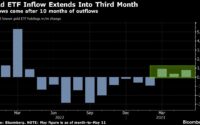Consumer confidence declines for first time since November
Consumer confidence took a step back in February.
The Conference Board’s Consumer Confidence Index for February registered its first decline since November, “reflecting persistent uncertainty about the US economy,” said Dana Peterson, chief economist at The Conference Board.
The index registered a reading of 106.7 in February, down from a revised level of 110.9 in January. January’s preliminary reading came in at 114, a two-year high for the measure. Economists surveyed by Bloomberg had expected a reading of 115 for February.
The Expectations Index, which measures consumers’ short-term outlook for income, business, and labor market conditions, fell to 79.8 in February from a revised 81.5 in January. Historically, a reading below 80 in that category signals a recession in the coming year.
“The drop in confidence was broad-based, affecting all income groups except households earning less than $15,000 and those earning more than $125,000. Confidence deteriorated for consumers under the age of 35 and those 55 and over, whereas it improved slightly for those aged 35 to 54,” Peterson added.
Notably, consumer worries in February were less about how much they’re paying at the gas pump or the grocery store but were more focused on recent headlines highlighting an uptick in white-collar layoffs and an increased focus on the looming presidential election.
Read more: Inflation update on everyday expenses: Prescription drugs down, pet care way up
“February’s write-in responses revealed that while overall inflation remained the main preoccupation of consumers, they are now a bit less concerned about food and gas prices, which have eased in recent months,” Peterson said. “But they are more concerned about the labor market situation and the US political environment.”
Tuesday’s print also comes at the end of what’s been a mixed bag of economic data to start the year.
January’s Consumer Price Index (CPI) and Producer Price Index reports earlier this month showed prices increased more than expected in the year’s first month and sparked fears that inflation may be stickier than initially forecast. The January retail sales report also disappointed, as consumer spending slipped more than expected.
These data points, in part, contributed to markets scaling back expectations for the Federal Reserve’s interest rate cuts later this year.
After initially expecting about six cuts this year, markets are now pricing in just three cuts for this year. Some economists, however, have cautioned that January’s releases were just one month of data and that it isn’t yet enough to change the overall narrative of a growing economy accompanied by moderating inflation.
As EY chief economist Gregory Daco told Yahoo Finance in an interview last Friday: “We had a month of January where, if I had the choice, I would essentially take all the data, put it in a bag, and put it aside because I think there was very little signal in the January data.”
Yahoo Finance senior reporter Alexandra Canal contributed reporting to this story.
Josh Schafer is a reporter for Yahoo Finance. Follow him on X @_joshschafer.
Click here for the latest stock market news and in-depth analysis, including events that move stocks
Read the latest financial and business news from Yahoo Finance
[ad_2]
Source link


